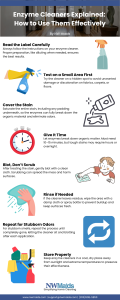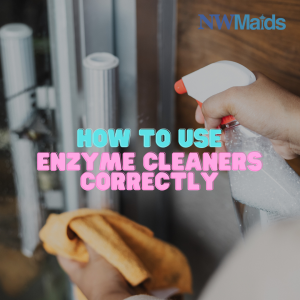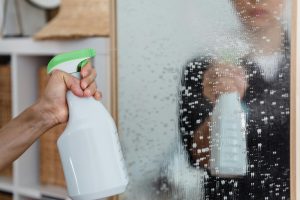
Enzyme-based cleaners are a powerful, eco-friendly solution for removing tough stains and persistent odors that traditional cleaning products often fail to handle.
Designed to break down organic messes through natural biological processes, enzyme cleaners provide effective results without relying on harsh chemicals.
Many homeowners prefer enzyme cleaners for pet accidents, food spills, and greasy surfaces, thanks to their reliability and versatility.
What Are Enzyme Cleaners?
Enzyme cleaners contain specialized enzymes that target and dissolve organic substances. Unlike conventional cleaners that may only mask odors or rely on aggressive chemicals, enzyme cleaners attack the source of the problem. Each enzyme serves a specific purpose:
-
Proteases break down proteins.
-
Amylases digest starches.
-
Lipases decompose fats and oils.
When combined, these enzymes form a versatile cleaning solution capable of handling stubborn household stains that standard cleaners often struggle with.
How Enzyme Cleaners Work on Different Surfaces
Enzyme cleaners are most effective on organic-based stains and odors, such as food spills, pet urine, wine, and sweat.
The enzymes break down these substances into smaller components that natural processes can neutralize.
Unlike chemical cleaners that mask odors temporarily, enzyme cleaners remove them at the source, preventing smells from returning once the fragrance fades.
These cleaners are safe for multiple surfaces, including carpets, upholstery, hardwood floors, tile, and grout. When used correctly, they won’t harm fibers or finishes, unlike bleach or ammonia-based products.
Benefits of Choosing Enzyme Cleaners
Some of the key advantages of enzyme cleaners include:
-
Eco-friendly formula: Uses natural proteins instead of harsh chemicals, making them safe for children and pets.
-
Low indoor air pollution: No strong fumes or irritants.
-
Versatility: A single bottle can tackle multiple cleaning tasks, reducing the need for specialized products.
How to Use Enzyme Cleaners Correctly
Read the Label Carefully
Always follow the manufacturer’s instructions. Some enzyme cleaners require dilution, while others can be applied directly. Proper preparation ensures the best results.
Test on a Small Area First
Even though enzyme cleaners are gentle, test them on a hidden spot of fabric, carpet, or flooring to avoid discoloration or damage.
Apply Generously to the Stain
For optimal results, ensure the cleaner fully saturates the stain or odor source. For pet urine, treat both the surface fibers and the padding underneath.
Allow Time for Enzymes to Work
Enzymes need time to break down organic matter. Most products require 10–15 minutes, but tough stains may need several hours or overnight treatment. Covering the area with a damp cloth can keep enzymes active longer.
Blot, Don’t Scrub
After the enzymes have worked, blot the area with a clean cloth or paper towel. Avoid scrubbing, which can spread the stain and damage surfaces.
Rinse When Necessary
Some enzyme cleaners need to be rinsed, while others can remain on the surface. If rinsing is required, use a damp cloth or spray bottle to remove residue, preventing buildup.
Reapply for Persistent Odors
Stubborn odors, such as pet urine in carpets, may need multiple applications. Apply, let sit, and blot until completely eliminated.
Store the Cleaner Correctly
Store enzyme cleaners in a cool, dry place, away from sunlight and extreme temperatures to maintain effectiveness.
Common Mistakes to Avoid When Using Enzyme Cleaners
-
Using too little product: Saturate the area for best results.
-
Not allowing enough time: Patience ensures enzymes fully break down stains.
-
Mixing with other cleaners: Avoid combining with bleach, ammonia, or harsh chemicals, as this deactivates enzymes.
Best Places to Use Enzyme Cleaners in Your Home
-
Carpets and Rugs: Ideal for pet accidents and food spills.
-
Upholstery and Mattresses: Removes body oils, sweat, and accidental spills. Always check fabric labels first.
-
Kitchen and Bathroom Surfaces: Effective against grease, soap scum, and mildew, especially in drains.
-
Laundry Pre-Treatment: Boosts detergent effectiveness on protein-based stains like grass, blood, or food.
Conclusion
For households dealing with stubborn stains and persistent odors, enzyme cleaners provide a safe, eco-friendly, and effective solution.
By following these tips, using enough product, allowing adequate time, and avoiding chemical mixing, you can achieve lasting results while protecting your surfaces.
And if maintaining your home feels overwhelming, NW Maids can help. Our professional team will handle your household cleaning tasks, leaving your home fresher, cleaner, and healthier.
Related Posts:
- How to Declutter and Clean a Garage in One Weekend
- How to Clean a Home After Hosting a Wedding or Event
- The Science of Dust: What It’s Really Made Of
- Top Traits of an Exceptional House Cleaner





